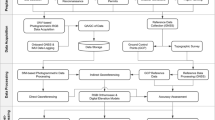Abstract
A recent improvement in measuring accuracy together with the development of new techniques suggests that geodetic point coordination to 1 part in 108 will become a reality in the near future. As a first step, however, the reference frame in which the points are to be coordinated, must be refined. Lunar Laser Ranging offers a means of solving both of these problems. The necessary equations are developed and the shortcomings of the method are analysed.
Similar content being viewed by others
Bibliography
P.L. BENDER, 1971: Dynamical Earth Information from Lunar Laser Range Data, Progress Report June 23, 1970–April 30, 1971, NASA W-13, 233.
F.L. CHOLLET, 1970: Mouvements de l’axe instantané de rotation de la Terre déduits des mesures laser de distance Terre-Lune, Astron. Astrophys. 9, 110–124.
G.M. CLEMENCE, 1966: Inertial Frames of Reference, Quart. J. Royal Astron. Soc. 7, 10–21.
F.A. FAJEMIROKUN, 1971: Applications of Laser Ranging and VLBI Observations for Selenodetic Control, Report No. 157, Department of Geodetic Science, The Ohio State University, Columbus, Ohio.
W. FRICKE, 1967a: Precession and Galactic Rotation Derived from McCormick and Cape Proper Motions in the Systems FK3, N30 and FK4. Astron. J. 72, 642–649.
W. FRICKE, 1967b: Precession and Galactic Rotation Derived from Fundamental Proper Motions of Distant Stars, Astron. J. 72, 1368–1369.
W. FRICKE & A. KOPFF, 1963: Fourth Fundamental Catalogue (FK4), Veroeffentlichungen des Astronomischen-Recheninstituts No. 10, Heidelberg.
H. GOLDSTEIN, 1950:Classical Mechanics, Addison-Wesley, Cambridge, Mass.
IUGG-IAG 1971: Geodetic Reference System 1967, International Union of Geodesy and Geophysics—International Association of Geodesy, Special Publication No. 3, Paris.
W.M. KAULA, 1973: Potentialities of Lunar Laser Ranging for Measuring Tectonic Motions, Phil. Trans. Royal Soc. Lond. A 274, 184–193.
R.S. MATHER, 1973: Four Dimensional Studies in Earth Space, Bull. Géodés. 108, 187–209.
P. MORGAN, 1974: Private Communication.
J.D. MULHOLLAND et al., 1973: A Self—Consistent Set of Surface Coordinates for the Apollo Lunar Laser Retroreflectors Deduced from Laser Range Measures, Space Research XIII, Akademie-Verlag, Berlin.
NASA-MIT Report, 1969: Solid Earth and Ocean Physics, Report of the Williamstown Study Group, Mass.
I.I. SHAPIRO & M.A. SLADE, 1973: The Orbit of the Moon, Final Report, October 1, 1969–December 31, 1972, AFCRL-TR-73-0133, Bedford, Mass.
Author information
Authors and Affiliations
Rights and permissions
About this article
Cite this article
Stolz, A. Geodetic uses of lunar laser ranging. Bull. Geodesique 115, 5–16 (1975). https://doi.org/10.1007/BF02523938
Published:
Issue Date:
DOI: https://doi.org/10.1007/BF02523938




